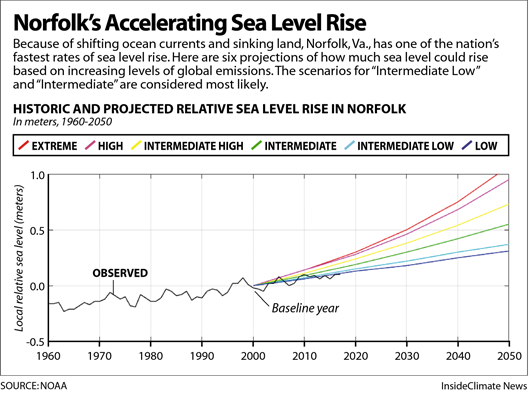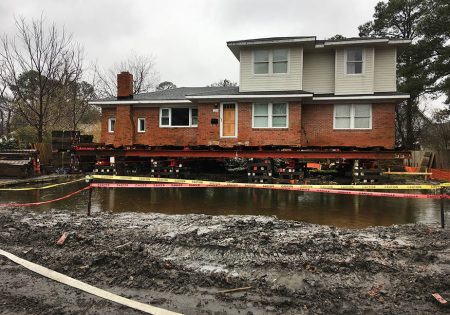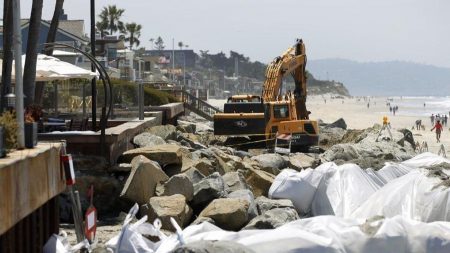May 22, 2018 – One city on the Atlantic Ocean and another on the Pacific are bracing for the consequences of climate change, a rise in sea level that will ultimately produce intermittent and then permanent flooding.
Norfolk, Virginia, is watching sea levels rise at twice the global average. Since 1992, that number is 15.24 centimeters (6 inches). Project the same rate of accelerating rise to 2050 (see graph below) and the seas off Norfolk will have risen over a half meter (16.5 inches).

Why sea levels are rising faster here than elsewhere along the Atlantic coast of the United States reflects a combination of two occurrences:
- changes to the ocean from global warming that cause expansion combined with changes to the offshore Gulf Stream impacted by that same warming.
- subsidence of the Chesapeake Bay area including much of Tidewater Virginia as isostatic rebound from the last Ice Age impacts the northern half of North America while causing more southerly parts of the continent to tilt downward.
Today Norfolk experiences tidal flooding regularly, twice as much as three decades ago. To combat the present and what it expects in the future, it means abandoning or repurposing areas of the city, creating adaptation zones where people will be discouraged from living, and fortifying other areas to keep rising seas away.
Norfolk Naval Station is right in the centre of an area in the city most vulnerable to the rising ocean. With little in the way of funding and plans from the U.S. Department of Defense to address the threat to the naval base, the city has called in experts from The Netherlands to help it with planning the future.
What appears to be in the future offing is the beginning of a great migration as Norfolk abandons areas at greatest risk while developing, improving and intensifying areas not at risk. City planners have, therefore, divided the city into zones that include areas of retreat as well as areas to be fortified. All new buildings in areas deemed at moderate risk need to be elevated a meter above the 100-year flood line. All new buildings in these zones have to capture rainfall in situ to the depth of 3.8 centimeters (1.5 inches) to prevent local ponding.

It is coincident that the areas most impoverished are also most at risk from flooding. The city, therefore, plans to knock down housing in these areas, and replace them with subsidized units located in safe, less flood-prone locations.
Norfolk’s intentions sound good but where the money will come from to remake the city remains a bit of a mystery. And Norfolk’s future is not too dissimilar to other towns and cities along the Atlantic seaboard where rising sea levels will displace millions of people from their homes by century end. The economic consequences amount to hundreds of billions of dollars in potential loss.
And as for the naval base, its tipping point is not that far away with sea level rise expected to impact critical operations by mid-century. The latter half of the 21st century may witness the abandonment of America’s premier Atlantic naval base. The cost to save it may prove too prohibitive.

Del Mar City, California, lies on the other side of the continental United States. It too is seeing sea level rise as a major threat and the city’s response is a strategy called “planned retreat.” In California, every coastal community is required to file a sea-level rise adaptation plan. Without one the city could lose its independent right to issue permits to build seawalls and authorize new construction of roads, buildings, and infrastructure.
What Del Mar’s adaptation strategy states is a plan to manage the city’s retreat from the encroaching Pacific Ocean by removing structures ahead of rising seas. Immediately impacted are some 600 homes, all in danger of inundation within the next decade. At these locations, the city’s managed retreat would mean the elimination of existing seawalls, roads and other infrastructure based on defined levels of risk. The city would compensate homeowners affected through a buy-back program and other forms of financial aid.
But Del Mar isn’t Norfolk. It is the rich people who are at risk of losing their homes here. These are glitzy residences that as recently as last year were selling at prices from $5 to $21.5 million. The owners of these properties don’t buy into managed retreat. They want to stay and rebuild beaches, and seawalls. Their resistance has put the city’s plans on hold for the moment because money talks.
California takes climate change more seriously than any other state in the U.S. It is most pessimistic about the lower numbers that define sea level rise off the coast of Norfolk. California is planning for up to 2 meters (over 7 feet) of rise by 2100 and cities polar sea ice melts and expansion from ocean warming as a threat that will continue beyond the century end.
So this is the tale of two cities facing the same problem. So many others are coming to grips with the same dilemma and trying to figure out the socio-economic costs. Saving what can be saved in coastal communities whether on the Atlantic or Pacific is a complicated business. The water waits for no one.
















[…] For coastal towns and cities, the foreknowledge should allow them to consider one of two strategies: […]
[…] in 2018, I wrote about how two coastal communities in the U.S. were coping with ocean inundation. Norfolk, Virginia was one. The other was Del Mar, […]